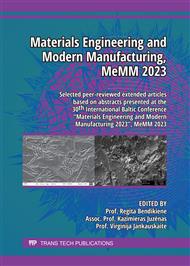[1]
S. Bose, S. Vahabzadeh, A. Bandyopadhyay, Bone tissue engineering using 3D printing. Mat. Today. 16(12) (2013) 496-504
DOI: 10.1016/j.mattod.2013.11.017
Google Scholar
[2]
M.L. Griffith, J.W. Halloran, Ultraviolet curing of highly loaded ceramic suspensions for stereolithography of ceramics, Solid Free. Fabr. Symp. (1994) 396-403.
Google Scholar
[3]
F.P. Melchels, J. Feijen, D.W. Grijpma, A review on stereolithography and its applications in biomedical engineering, Biomat. 31(24) (2010) 6121-6130
DOI: 10.1016/j.biomaterials.2010.04.050
Google Scholar
[4]
M. Pfaffinger, G. Mitteramskogler, R. Gmeiner, J. Stampfl, Thermal debinding of ceramic filled photopolymers, Mat. Sci. Forum. 825-826 (2015) 75-81
DOI: 10.4028/www.scientific.net/MSF.825-826.75
Google Scholar
[5]
R.Z. LeGeros, Biodegradation and bioresorption of calcium phosphate ceramics, Clin. Mat. 14(1) (1993) 65-88
DOI: 10.1016/0267-6605(93)90049-D
Google Scholar
[6]
A. Bandyopadhyay, S. Bernard, W. Xue, S. Bose, Calcium phosphate-based resorbable ceramics: Influence of MgO, ZnO, and SiO2 Dopants, J. Am. Ceram. Soc. 89 (2006) 2675-2688
DOI: 10.1111/j.1551-2916.2006.01207.x
Google Scholar
[7]
A. Bandyopadhyay, J. Petersen, G. Fielding, S. Banerjee, S. Bose, ZnO, SiO2, and SrO doping in resorbable tricalcium phosphates: Influence on strength degradation, mechanical properties, and in vitro bone-cell material interactions. J. Biomed. Mater. Res. B Appl. Biomater. 100 (2012) 2203-2212
DOI: 10.1002/jbm.b.32789
Google Scholar
[8]
S. Bose, S. Tarafder, S.S. Banerjee, N.M. Davies, A. Bandyopadhyay, Understanding in vivo response and mechanical property variation in MgO, SrO and SiO2 doped beta-TCP, Bone. 48 (2011) 1282-1290
DOI: 10.1016/j.bone.2011.03.685
Google Scholar
[9]
G. Mestres, C. Le Van C, M.P. Ginebra, Silicon-stabilized α-tricalcium phosphate and its use in a calcium phosphate cement: Characterization and cell response. Acta Biomater. 8 (2012) 1169-1179
DOI: 10.1016/j.actbio.2011.11.021
Google Scholar
[10]
D. Ke, S. Tarafder, S. Vahabzadeh, S. Bose, Effects of MgO, ZnO, SrO, and SiO2 in tricalcium phosphate scaffolds on in vitro genes expression and in vivo, Mater Sci Eng C Mater Biol Appl. (2019) 96 10-19․
DOI: 10.1016/j.msec.2018.10.073
Google Scholar
[11]
J. Eisinger, D. Clairet, Effects of silicon, fluoride, etidronate and magnesium on bone mineral density: a retrospective study, Magnes Res. 6 (1993) 247-249.
Google Scholar
[12]
R. de Melo Bernardino, C. Wirth, S.L. Stares, G.V. Salmoria, D. Hotza, J. Günster, Manufacturing of SiO2-coated b-TCP structures by 3D printing using a preceramic polymer as printing binder and silica source, J. Cer. Sc. Tech. 9(1) (2018) 37-42
Google Scholar
[13]
W. Haidong, Ch. Yanling, W. Liu, H. Rongxuan, Z. Maopeng, W. Shanghua, X. Song, Y. Chen, Effect of the particle size and the debinding process on the density of alumina ceramics fabricated by 3D printing based on stereolithography, Curr. Op. Sol. St. Mat. Sc. 21(9) (2017) 323-347
DOI: 10.1016/j.ceramint.2016.08.024
Google Scholar
[14]
Information on: https://formlabs-media.formlabs.com/datasheets/2001037-SDS-ENCA-0.pdf
Google Scholar
[15]
V. Truxova, J. Safka, M. Seidel, I. Kovalenko, L. Volesky, M. Ackermann, Ceramic 3D printing. Comparison of SLA and DLP technologies, MM Sci. J. (2020) 3908-3911
DOI: 10.17973/MMSJ.2020_06_2020006
Google Scholar
[16]
Information on: https://media.formlabs.com/m/012f4949683b3fc2/original/-ENUS-Ceramic-Resin-Usage-Design-Guide.pdf
Google Scholar
[17]
ISO 23242:2020(en). Information on: https://www.iso.org/obp/ui#iso:std:iso:23242:ed-1:v1:en
Google Scholar
[18]
F. Gervaso, S.K. Padmanabhan, F. Scalera, A. Sannino, A. Licciulli, Mechanical stability of highly porous hydroxyapatite scaffolds during different stages of in vitro studies, Mat. Lett. 185 (2016) 239-242
DOI: 10.1016/j.matlet.2016.08.139
Google Scholar
[19]
D. dos S.Tavares, L. de O. Castro, G.D. de A. Soares, G.G. Alves, J.M. Granjeiro. Synthesis and cytotoxicity evaluation of granular magnesium substituted b-tricalcium phosphate, J. Appl. Oral Sci. 21(1) (2013) 37-42
DOI: 10.1590/1678-7757201302138
Google Scholar
[20]
M.J. Buerger, The role of temperature in mineralogy, Am. Mineral. 33 (1948) 101-121.
Google Scholar
[21]
M.J. Buerger, Crystallographic aspects of phase transformations, Am. Mineral. (1951) 183-211.
Google Scholar
[22]
R.G. Carrodeguas. A.H. De Aza. X. Turrillas, P. Pena, S. De Azaw, New approach to the β-α polymorphic transformation in magnesium-substituted tricalcium phosphate and its practical implications, J. Am. Ceram. Soc. 91 (2008) 1281-1286
DOI: 10.1111/j.1551-2916.2008.02294.x
Google Scholar



